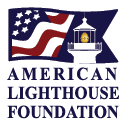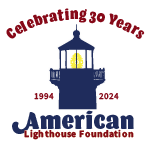Whaleback Light’s Century-Old “Signature” Makes a Return
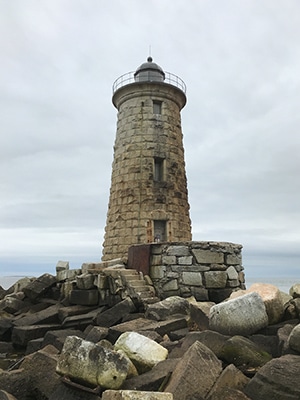
Whaleback Lighthouse, built in 1872.
(Photo by Bob Trapani, Jr.)
The year was 1912 when the flashing characteristic for Whaleback Lighthouse was changed to two quick flashes every ten seconds. Back then, these gleams were produced by a revolving bi-valve fourth order Fresnel lens with two bull’s-eye panels. Inside the classical lens, an incandescent oil vapor system provided the light source.
For the next ninety-seven years – in rotating fashion, bursts of guiding beams marched forth over a darkened sea. Whaleback Lighthouse “signed its signature” with a double-flash at ten second intervals in the hearts and minds of mariners and landlubbers alike for nearly a century.
Eventually, the beautiful Fresnel lens would give way to a DCB-224 aero beacon outfitted with 1000-watt lamps. Later, a VRB-25 rotating beacon would supplant the beefy aero beacon. However, through the evolution of optics, one common thread was maintained – the light’s rotation.
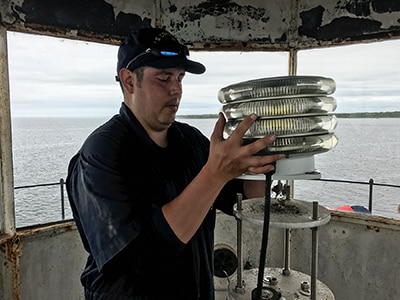
EM1 Esteven Penuela of USCG ANT South Portland removing the VLB-44 LED beacon in Whaleback Light.
(Photo by Bob Trapani, Jr.)
This changed in 2009 when cutting-edge technology in the form of a light emitting diode beacon was installed by the United States Coast Guard at Whaleback Lighthouse. The four-tier VLB-44 LED beacon was unto itself an amazing unit. The sturdy beacon’s light was quite bright and its efficiency was near impeccable.
The VLB-44 LED beacon is lauded in maritime circles the world over for its radiant countenance – all of which requires no moving components to encumber its robust efficiency. The unit’s gleams are sharp and spry, its hue all business with each crisp flash.
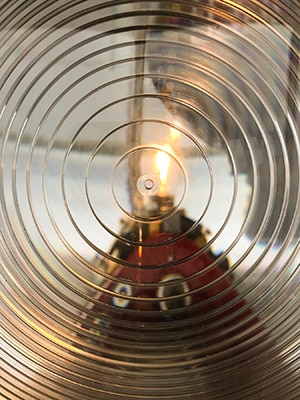
One of six bull’s-eyes in a VRB-25 beacon.
(Photo by Bob Trapani, Jr.)
However, what was lost in this progression was tradition’s common thread at Whaleback Lighthouse – beams of light sent forth in rotating fashion. Residents along the coastal communities of Kittery Point, Maine and New Castle, New Hampshire missed admiring the revolving warm light emitting from the supplanted VRB-25 rotating beacon. The former light’s star-burst through each bull’s-eye and subsequent slow fade aglow was a visual treasure for many people.
The winds of change started to gather strength in 2021 when local residents, such as Sam Reid of Kittery Point, clamored to see a rotating light return to Whaleback Lighthouse. Mr. Reid is wonderfully enthusiastic about restoring history within the unique maritime complex of the Piscataqua River, whose riverbanks are shared by the states of Maine and New Hampshire. Evidence of Mr. Reid’s leadership, vision and commitment to preserving our maritime history is the shining example of the fully restored 1908 Wood Island Life-Saving Station, which is situated 0.4 miles north of Whaleback Lighthouse.
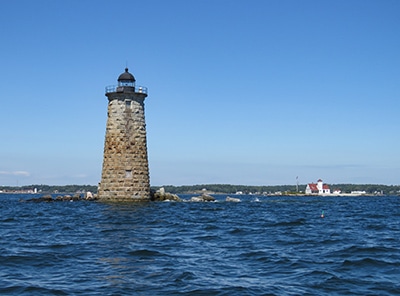
Whaleback Lighthouse and Wood Island Life-Saving Station (seen in the distance on right) are part of a unique maritime complex along the Piscataqua River.
(Photo by Bob Trapani, Jr.)
Sam Reid approached the American Lighthouse Foundation (ALF), which is the steward of the 1872 Whaleback Light, about the idea of returning a rotating light to the wave-swept sentinel. ALF’s leadership ardently embraced the concept – and along with other Maine and New Hampshire maritime stakeholders, initiated dialogue with the U.S. Coast Guard’s First District in Boston and the USCG Aids to Navigation Team South Portland, Maine.
The Coast Guard was understanding of the community’s desire and subsequently embarked on efforts to determine how best to satisfy the request. The collaboration between the American Lighthouse Foundation, local communities, maritime stakeholders and the United States Coast Guard was nothing short of amazing!
Upon conclusion of the aids to navigation study process in spring 2022, the Coast Guard agreed to reinstall a VRB-25 rotating beacon back in Whaleback Lighthouse.
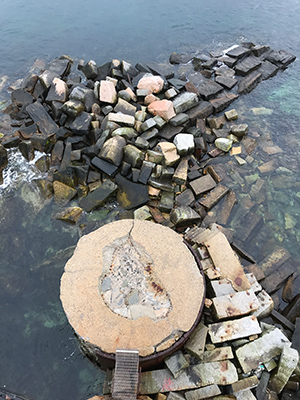
Landing at Whaleback Lighthouse is challenging even on the best of days.
(Photo by Bob Trapani, Jr.)
Obtaining administrative authorization to remove the VLB-44 LED beacon in favor of the incandescent VRB-25 rotating beacon was one thing; however, actually implementing the change in optics at the offshore location was where the real challenge would prove to be.
For Whaleback Lighthouse is a classic wave-swept tower with no landing facilities and scant ideal approaches. To complicate matters even further, boat access must be done around the high tide – and only on days when the seas are hospitable to safely effect a landing.
Most people do not give much consideration as to the complexities of installing a new system at a lighthouse. There is no such thing as a “plug & play” process. The authorization order for transitioning back to a VRB-25 rotating beacon would require all new equipment, including updated solar calculations to support the increased power consumption of the beacon.
And though the U.S. Coast Guard Aids to Navigation Team South Portland – led by Officer-in-Charge BMCS Clayton Franklin, excels at these types of challenges, it did not lessen the overall intricacy of the process.
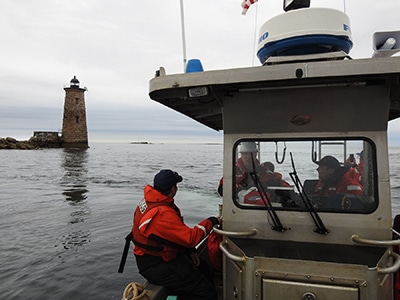
USCG ANT South Portland made multiple trips to Whaleback Light in an effort to complete the optic change.
(Photo by Bob Trapani, Jr.)
BMCS Clayton Franklin and his talented team spent time on vital planning, secured the necessary parts and equipment and then kept watch for suitable weather windows to begin carrying out the mission. A single trip to the lighthouse would not be sufficient.
The aids to navigation team (ATON) made multiple trips over a period of weeks, as weather would permit, to obtain measurements, identify challenges to logistics and for staging tools and equipment at a location fraught with large irregular and slippery granite rocks. To compound matters, the ATON team was always in a race against the clock at Whaleback as the tide waits for no one. Each day’s work had to be carried out within a limited window of time.
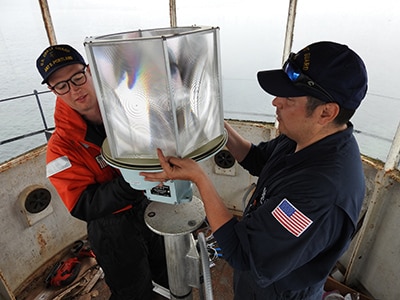
(L to R) EM1 Francis Ferster and EM1 Esteven Penuela installing a VRB-25 rotating optic in Whaleback Light.
(Photo by Bob Trapani, Jr.)
On June 1, 2022, the U.S. Coast Guard Aids to Navigation Team South Portland set out to complete the transition from the VLB-44 LED beacon to the VRB-25 rotating beacon. By the time the tide determined it was time to go, the new light was shining bright and watching properly.
“Although the way the light is delivered to the mariner has now been changed, the actually flash characteristics will remain the same at Fl (2)W 10s (a white light flashing twice every ten seconds),” said BMCS Clayton Franklin. “The change to the rotating beacon increases the nominal range of the light from 11 nautical miles to 12 nautical miles. This conversion also includes the installation of three 100 watt solar panels and four batteries as a primary power source.”
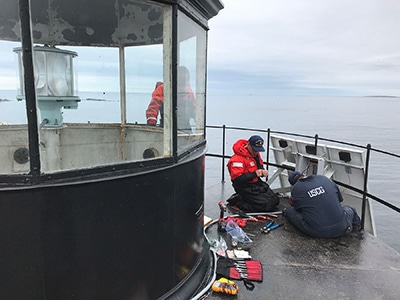
(L to R) EM1 Francis Ferster and EM1 Esteven Penuela installing new solar panels at Whaleback.
(Photo by Bob Trapani, Jr.)
BMCS Franklin went on to note, “Whaleback Light has served as a beacon marking the entrance to the Piscataqua River for 150 years and through the hard work and support of the American Lighthouse Foundation and the USCG Aids to Navigation Team South Portland, Maine, it will continue to guide mariners safely in and out of port for years to come.”
Though Whaleback Lighthouse is a federal aid to navigation and its light and fog horn is maintained by the U.S. Coast Guard, the structure itself is owned by the American Lighthouse Foundation and cared for by ALF’s chapter, Friends of Portsmouth Harbor Lighthouses. The nonprofit organization was very happy to see a rotating beacon returned to this stalwart sentinel.
“Most people who live on the New Hampshire seacoast or in southern Maine are familiar with the rugged granite lighthouse known as Whaleback,” said ALF President Jeremy D’Entremont. “It’s an icon by day, but its navigational light has been its reason for being for almost 200 years.”
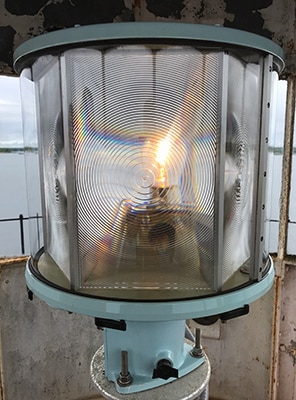
Whaleback Light’s VRB-25 rotating beacon.
(Photo by Bob Trapani, Jr.)
D’Entremont further stated, “For most of those years, it had a rotating light that sent out a flash to guide mariners past the dangerous ledge at the mouth of the Piscataqua. The rotation ceased with the installation of a flashing LED optic in 2009, but now the distinctive rotating light is back, thanks to the Coast Guard. Whaleback once again serves not only as a still important navigational aid, and also as a guide to our lighthouse heritage.”
This present day team effort to reestablish a rotating beacon is a heartwarming story and will prove to be yet another fascinating chapter in Whaleback Light’s legendary history. Thank you to the United States Coast Guard and our local coastal communities for caring so much and helping “keep the light shining!”
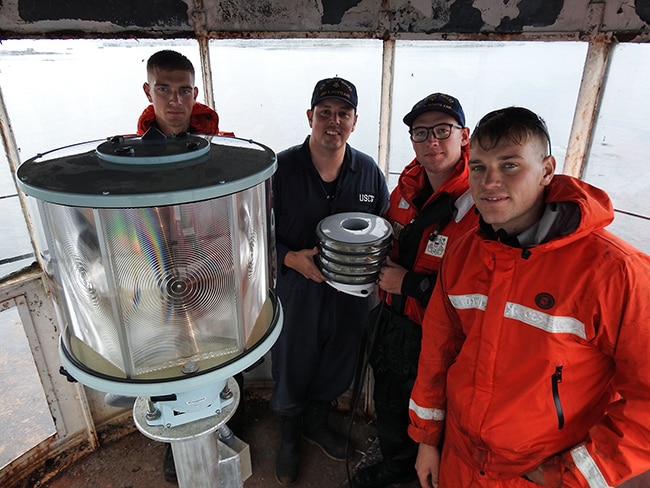
(L to R) FN Jason Yelle, EM1 Esteven Penuela, EM1 Francis Ferster and MK3 Brandon Grant of U.S. Coast Guard Aids to Navigation Team South Portland, Maine, completed the evolution of changing the optic inside Whaleback Lighthouse from a VLB-44 LED beacon to an incandescent VRB-25 rotating beacon on June 1, 2022.
(Photo by Bob Trapani, Jr.)
